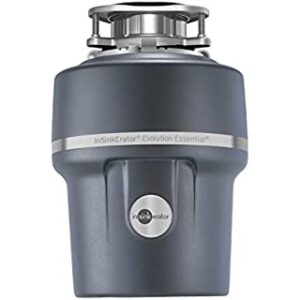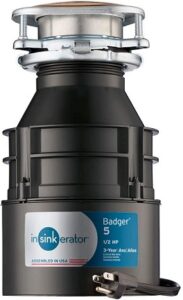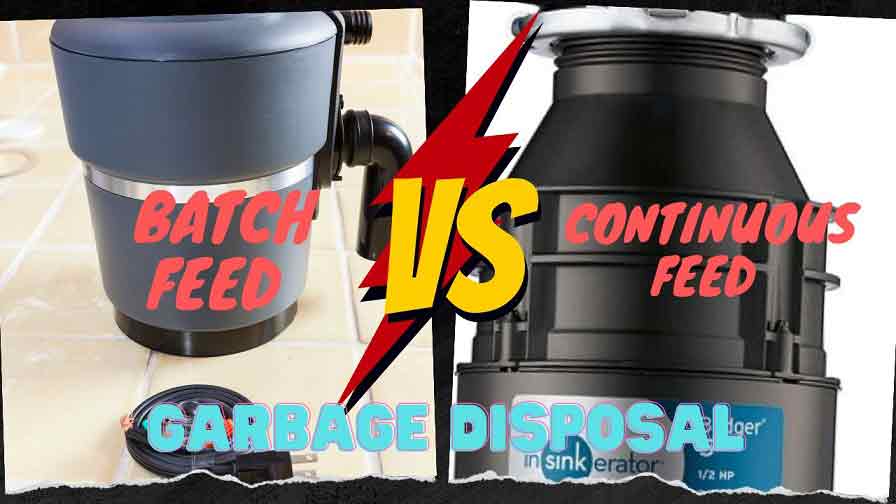Garbage disposal is the most common household item among kitchen appliances; nowadays, it can be seen in almost any house. It especially makes homeowners’ lives easier and cleaner than before.
In the market, you can see so many different types of garbage disposals, which differ in functionality, performance, and usability. So when a beginner decides to buy garbage disposals like InSinkErator, Moen, or Waste King for their kitchen, they get confused while looking at various model disposal, especially if they have no idea about different garbage disposal types.
In shortly saying, most commonly, you can see 2 types of garbage disposal in the market, and they are batch feed and continuous feed.
However, most consumers do not have a detailed idea about the different garbage disposal, so they select the wrong disposal, which later causes hassle for them. That’s why we created this quick and effective guide so that you get a detailed idea about different disposers and pick the most suitable food waste disposer for your kitchen.
Also read: Garbage disposal baffle
Table of Contents
Different Types of Garbage Disposal: How to Decide Which Garbage Disposal Should I Buy?
As we mentioned earlier, there are 2 types of modern garbage disposal in the market: batch feed and continuous feed. The two disposers are very different in terms of functionality, kitchen setup, installation, and budget. We have highlighted it below; let’s take a look.
i. Batch Feed Garbage Disposal

The batch feed disposer is well known for its most powerful grinding. One of its special features is that you can grind any kind of food waste in it. That’s why you don’t have to worry about separating waste like bones, proteins, fats, and fibrous materials.
Its usability is much easier than other garbage disposals. Particularly the stopper in the batch feed has made its grinding process safer and prevented accidentally putting children’s hands or falling wrong objects in the chamber.
To run the batch feed disposer, remove the stopper from the garbage disposer opening, place enough food waste into the disposer chamber unit, and run the water flow. After that, put the stopper over the disposer opening. Finally, turn on the garbage disposal switch.
The top disadvantage of batch feed is that it is much more expensive than standard garbage disposals.
Advantages
- Compared to regular disposers, it is very quiet.
- One of the unique features of batch feed is its stopper protector, which prevents random objects from dropping directly into the chamber.
- It is relatively easy to operate; simply put the stopper, and it will run.
- Does not use excessive water like continuous feed.
- It also has an energy-saving feature.
Disadvantages
- Its price is comparatively more expensive.
- Can’t grind all at once continuously; you have to grind piece by piece. Also, sometimes you have to wait if the chamber is not full.
- Due to its large size, it is not suitable for a limited-space kitchen.
Read Now: Best Batch Feed Garbage Disposal
ii. Continuous Feed Garbage Disposal

Continuous feed is the most common disposer, which you can see almost everywhere. It is called continuous garbage disposal because it grinds continuously. Basically, after running it once, it will continue to run until you turn it OFF, so it is relatively easy to operate.
In batch feed disposers, when the stopper is put over, it can automate turn-off; that feature is not in continuous feed disposers. So you can continuously throw food waste into the chamber; you don’t have to stop frequently like batch feed.
But the top disadvantage of continuous feed is that it cannot handle wastages like proteins, fats, and fibrous, so in this case, you have to separate them before grinding.
Advantages
- Continuous feed disposer comes with a compatible design, that’s why it can fit limited spaces.
- This disposer is the best option when you want to grind a huge amount of waste at a time.
- Clean-looking design, keep your kitchen organized.
- Its price is very inexpensive compared to other disposers
- Mostly available, easy to maintain
Disadvantages
- The standard continuous disposer sounds slightly louder.
- Since its opening part is always open, there are more chances of random objects falling directly into the chamber while the machine runs.
- It uses excessive water because you need to keep the water flow running as long as you are disposing of the waste.
Read Now: Best Continuous Feed Garbage Disposal
Batch Feed vs Continuous Feed Garbage Disposal

Well, I think you have got a useful opinion about the two disposers described above. Now let’s briefly know the main differences between these two main food waste disposers so that you can get a better idea about which one can be the most suitable option for you.
| Features | Batch Feed | Continuous Feed |
| Safety Cover | ✅ | ❎ |
| Food Waste Capacity | Large waste capacity | Small or medium waste capacity |
| Under Sink Space | Not good for limited space | Good option for small to medium kitchen |
| Noise | Low | Mostly louder |
| Price | So expensive | Budget-friendly |
Also Read: What is the Difference Between 1/2 and 3/4 Garbage Disposal: What HP Do I Need?
Final Verdict
Hopefully, our types of garbage disposal guide have helped you a lot to get familiar with different disposers. Besides, our comparison guide has also helped you know the difference between the two main disposers. Enjoy more guides about garbage disposal? Then stay with us.
Related Post:
Best InSinkErator Garbage Disposal
Best Waste King Garbage Disposal
How Does Ice Sharpen Garbage Disposal Blades?
How to Turn ON InSinkErator Garbage Disposal
How to Get Rid of Smell from Garbage Disposal
How to Keep Garbage Disposal Hot Or Cold Water
How to Fix a InSinkErator Garbage Disposal
Do Garbage Disposals Have Blades
How to Replace an InSinkErator Garbage Disposal
How to Unjam InSinkErator Garbage Disposal

Williams Kane is a blogger and writer. He’s passionate about writing and connecting with the community, especially when it comes to sharing his ideas through writing.
I am a versatile author with a passion for exploring a wide range of topics on our multi-niche website. With a background in research and a love for writing, I bring a unique blend of expertise to our platform.
My journey began in the world of science, where I earned a degree in biology and developed a deep fascination for the natural world. This background enables me to delve into topics related to ecology, environmental conservation, and the wonders of the animal kingdom.
However, my curiosity knows no bounds, and I have ventured into various other niches as well. From technology trends and digital innovations to health and wellness tips, I strive to provide well-researched and engaging content that informs and entertains our diverse audience.
Furthermore, my dedication to staying current with the latest developments in each niche ensures that our readers receive up-to-date and reliable information. Whether it’s deciphering complex scientific concepts or simplifying tech jargon, I take pride in making complex subjects accessible to all.
Join me on our multi-niche journey, where we explore the depths of knowledge and share insights on a multitude of topics to inspire, educate, and entertain.








